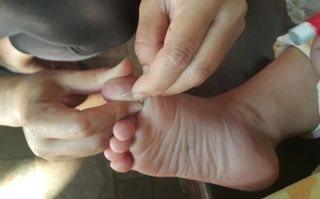
..................................................................................................................................................
Splinters In The Skin
What Happens If
You Don't Take Out a Splinter?
By Yasemin Saplakoglu - Staff
Writer
It
can be a freeing feeling to shuck off your shoes and walk outside barefoot
during the warm spring and hot summer, until the deck sticks your exposed foot
with a tiny, pointy gift: a splinter.
But
it's so tiny or so deeply stuck in the skin that you can't get it out. So, what
would happen if you just left it in?
It's
best not to wait and see, as leaving a splinter in the body can provide a
passageway for infection, said Ashley Jones, a certified nurse practitioner at
The Ohio State University Wexner Medical Center.
The
"skin is a physical barrier that prevents infections," Jones
told Live Science.
So,
a splinter that breaks that skin "makes it easier for bacteria outside
of the skin to actually get under the skin."
That
bacteria may already be on the splinter, holding on for a free ride into the
bloodstream, or it may make its way in through the open gates after the
incursion.
One
such infection is caused by the tetanus bacteria (clostridium tetani),
which, if it makes its way into the body of a person who is not vaccinated or
up to date on their tetanus boosters, can release toxins that harm the nervous
system.
Because
of the risk of infection, "I would generally recommend that you not
leave a splinter in place," Jones said.
If
you can't easily grab it with tweezers and by applying a slow, steady pressure,
"I would recommend just seeking health care," she said.
Dr.
Jefry Biehler, chair of pediatrics at Nicklaus Children's Hospital in Miami, echoed
this recommendation.
If
removing a deeply embedded splinter at home may result in a
lot of bleeding, then head to a health care center, where professionals can
remove the splinter using clean, sterile instruments, he said.
If
the splinter isn't removed, the body probably won't absorb the invader or break
it down.
Rather,
the body will likely try to push the splinter out, Biehler said.
The
splinter may cause an inflammatory reaction, which could mean swelling and
redness in that area.
What's
more, pockets of pus may form to help expel the
splinter.
If
the inflammatory response continues for a number of days or weeks, the area can
sometimes develop a somewhat permanent bump or what's called a
"granuloma," Jones added.
This
is kind of a protective bubble of immune cells that surround the foreign object
the body wasn't able to oust.
Sometimes
the body can naturally expel a splinter from the skin
without causing an inflammatory response, Biehler said.
Other
times, the splinter may stay in the skin forever.
Biehler
noted that one of his nurse friends has had an inch-long thorn in her hand for
the past 40 years. "You can feel it, she can move it … [but] it doesn't
cause her any pain," he said.
"She's been fine for 40 years." The splinter doesn't
carry as big of a risk of infection as when she first got it, because the skin
closed on top of it, he added.
"It is a fine line between what needs to be seen [by a
doctor], what needs to be removed and what can be left alone," Biehler said.
But
in general, splinters you get around the house or those that come from plant
materials, such as wood, "usually need to come out, because the body
reacts to it."
In
any case, foreign bodies lodged in the skin — especially in children and the
elderly, who may be more prone to infections — should be evaluated by a health
care professional, he said.
Yasemin
Saplakoglu
Staff
Writer
Yasemin
is a staff writer at Live Science, writing about biology and neuroscience,
among other science topics. Yasemin has a biomedical engineering bachelors from
the University of Connecticut and a science communication graduate certificate
from the University of California, Santa Cruz. When she's not writing, she's
probably taking photos or sitting upside-down on her couch thinking about
thinking and wondering if anyone else is thinking about thinking at the exact
same time.


No comments:
Post a Comment